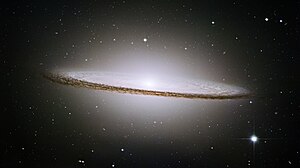Sombrero Galaxy
| Galaxy Sombrero Galaxy |
|
|---|---|

|
|
| The Sombrero Galaxy as seen by the Hubble Space Telescope . | |
| AladinLite | |
| Constellation | Virgin |
|
Position equinox : J2000.0 , epoch : J2000.0 |
|
| Right ascension | 12 h 39 m 59.4 s |
| declination | −11 ° 37 ′ 23 ″ |
| Appearance | |
| Morphological type | SA (s) a; LINER Sy1.9 |
| Brightness (visual) | 8.3 mag |
| Brightness (B-band) | 9.2 likes |
| Angular expansion | 8.6 ′ × 4.2 ′ |
| Position angle | 89 ° |
| Surface brightness | 12.0 mag / arcmin² |
| Physical data | |
| Redshift | (3416 ± 17) · 10 −6 |
| Radial velocity | +1024 ± 5 km / s |
|
Stroke distance v rad / H 0 |
(40 ± 3) x 10 6 ly (12.4 ± 0.9) Mpc |
| Dimensions | 8 · 10 11 M ☉ |
| diameter | 50,000 ly |
| history | |
| discovery | Pierre Méchain |
| Discovery date | April 9, 1781 |
| Catalog names | |
| M 104 • NGC 4594 • UGC 293 • PGC 42407 • MCG -2-32-20 • IRAS 12373-1120 • GC 3132 • h 1376 • H I 43 | |
The Sombrero Galaxy is a spiral galaxy in the constellation Virgo . In the Messier catalog it has the number M 104 .
discovery
M 104 was discovered on April 9, 1781 by Pierre Méchain , as stated in a letter on May 6, 1783. In the same year on May 11th, Charles Messier added them to his catalog. Independently of this, Wilhelm Herschel discovered the galaxy on May 9, 1794.
Location and appearance
M104, also known as NGC 4594, lies in the constellation of Virgo and appears to be near the Virgo Galaxy Cluster . However, at a distance of 30 million light years, the Sombrero Galaxy is a lot closer to the Milky Way than this galaxy cluster and is therefore not considered a member of this cluster. The brightness of this spiral galaxy is 8.0 magnitude classes. This makes this spiral galaxy one of the apparently brightest in the night sky and visible in every small telescope. The apparent extension is 9 minutes of arc along the major axis, i.e. a good quarter of the moon's diameter. This corresponds to a true diameter of about 50,000 light years. In the outdoor areas there is also a very extensive, weakly glowing halo . The mass of the galaxy is estimated at around 800 billion solar masses (for comparison: According to new research findings, the mass of the Milky Way is estimated at 1.9 trillion and that of the Andromeda galaxy at 1.2 trillion solar masses). The discovery that the central supermassive black hole of the comparatively small Sombrero Galaxy far exceeds those of the Milky Way and Andromeda in gravity came as a surprise to the astronomers . With around 1 billion solar masses, it is ten times as massive as the black hole in the center of M31 and around 240 times as large as Sagittarius A * in the galactic center . It appears that a pronounced bulge correlates strongly with the mass in the central black hole.
In the Hubble sequence , this spiral galaxy is classified under the type Sa or Sb. It has an exceptionally large and bright core and has very tightly wound spiral arms. However, the latter are difficult to see because the galaxy plane is only slightly inclined to the line of sight, i.e. H. we are practically looking sideways at this galaxy. The very dark and very pronounced band of dust that spins the galaxy gives it the typical appearance that is reminiscent of a Mexican sombrero .
M104 has a fairly well-populated system of globular clusters , several hundred of which are visible in larger telescopes. The total number is estimated at over 2000 and thus far exceeds the number of globular clusters in the Milky Way.
In 1912 Vesto Slipher discovered that the Sombrero galaxy had a very large redshift for the time . The resulting speed at which the galaxy moves away from the Milky Way is a good 1,000 kilometers per second. This speed is so high that the galaxy will cover a distance within about 10 million years that corresponds to the radius of the Milky Way. From this it became clear as early as 1912 that this object could not be a permanent member of the galaxy group (cluster) of the Milky Way, as was still assumed at that time.
Image taken in infrared by the Spitzer Space Telescope
UV exposure using GALEX
Web links
Individual evidence
- ↑ a b c d NASA / IPAC EXTRAGALACTIC DATABASE
- ↑ a b c d e SEDS : NGC 4594
- ↑ Seligman
- ↑ Hannelore Hämmerle, Ralf Bender: Dark matter does not act as a growth factor. Rather, galaxy bulges determine the mass of central black holes. , Max Planck Society , January 21, 2011




